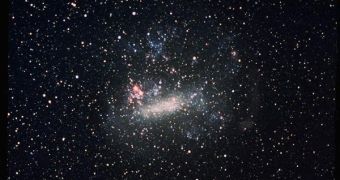Scientists have recently determined that the Magellanic Stream, a gigantic cloud of gas flowing outwards from the Magellanic Cloud, is in fact older and larger than previously determined. The recent finding, researchers believe, could provide astronomers with fresh insight into the events that determined the formation of the cloud, and also into the phenomena that made it start moving outside of our neighboring galaxies in the first place, PhysOrg reports.
For the new observations, astronomers used the Robert C. Byrd Green Bank Telescope (GBT), an instrument of the US National Science Foundation (NSF). The main goal of the new investigation was to determine whether the Magellanic Stream and other patches of gas that were discovered in other studies were part of one and the same system. This question has been puzzling astronomers for over 30 years, but available data could not paint a clear picture. Now, thanks to the recent study, we have a chance to put this issue to rest once and for all.
“We now have answered that question. The stream is continuous. We now have a much more complete map of the Magellanic Stream,” University of Virginia expert David Nidever said. The scientist spoke yesterday in Washington DC, at the 215th meeting of the American Astronomical Society (AAS). Nidever said that he and his team had gathered more than 100 hours of observations of the Magellanic Cloud and Stream with the GBT. Then, they combined their information with other data sets, obtained by telescopes around the world, and were able to determine that the Stream was, in fact, 40 percent longer than originally calculated.
This means that it also had to be older than estimated, he added at the AAS meeting. It would now appear that the Stream emerged about 2.5 billion years ago. “The new age of the stream puts its beginning at about the time when the two Magellanic Clouds may have passed close to each other, triggering massive bursts of star formation. The strong stellar winds and supernova explosions from that burst of star formation could have blown out the gas and started it flowing toward the Milky Way,” Nidever explained.

 14 DAY TRIAL //
14 DAY TRIAL //